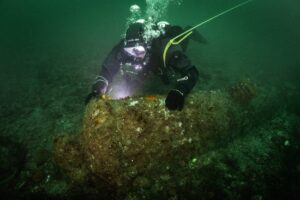Ecuador’s Galapagos Islands are an archipelago consisting of 13 main islands (five of which are inhabited), seven minor islands and more than 200 islets and rocks found about 600 miles off South America’s Pacific coast. Before they were the Galapagos, the islands were called “Las Encantadas” for the way they captured the imaginations of their visitors, most famously Charles Darwin, but it is absolutely something they still do to this day.
The harsh volcanic landscapes of the Galapagos host creatures found nowhere else on Earth. The archipelago’s remoteness and stark landscapes left it unclaimed and uncolonized, protecting its nature. This serendipity, combined with the founding of the Galapagos National Park in 1959, means that a full 90 percent of the islands’ original biodiversity survives in what has become a natural time capsule. You can see why it is so many peoples’ bucket list destination.
While life on land here is tough, these challenges do not extend under the surface. For ocean life, the archipelago is an Eden providing almost perfect conditions year-round for marine species to flourish with a magnitude and vitality few locations on the planet can match. While the archipelago straddles the equator, the waters are not the picture-perfect crystal blue of the tropics because of the composition and location of the islands, which are actually the tips of a 3-mile-high volcanic ridge spiking precipitously from the ocean floor. Four major ocean currents converge and collide with this barrier, forcing fertile, deep ocean water to the surface. Here the water encounters high-octane tropical sunlight that sparks an explosion of phytoplankton and in turn supercharges the entire marine food chain. These nutritious waters are the reason that these seas churn with big creatures and countless fish.
While it is easy to talk about the amazing encounters with hammerheads and huge whale sharks, dolphins, fur seals, sea lions, turtles, mantas, eagle rays and much more, it is also important to remind people that Galapagos is one of the most challenging dive destinations and something to build up to, not race towards in your diving career, so that when you get there you have a truly wonderful experience. Conditions are hard to predict: the water is regularly cold, visibility can be poor, and strong currents are common, which can be particularly intimidating in such a remote, open ocean location. Many divers find the challenge addictive because it makes the rich rewards all the sweeter. For others, Galapagos is a location which they will tell tales about on every future dive trip, but one they are content to leave unrepeated.
How cold can the ocean be at the equator? The answer is surprising. Every diver has a different level of tolerance to chilly water, but on the dives along the western edge of the archipelago, the ocean is cold enough that everyone on my trip feels it! The guides on the Galapagos Master don drysuits for these dives, but I was fine in my 7mm Flexa Graphene, with 5mm Flexa gloves. Expecting to be breathing hard at times, I took my best regulator, the Epic 82X and my toughest BC the Dragon SLS. Powerful fins are important in Galapagos, so I took my freediving fins, which are the classic Razors. There are high-performance freediving fins, but I find the Razors perfect when I need them for scuba in destinations such as this. Many dives involve hooking or clinging to the rocks while trying to hide from the current and occasionally sprinting out into the blue to intercept a larger creature like a whale shark, and then drift on with a curtain of hammerheads. Powerful fins make a big difference.
Is Galapagos heaven on Earth for underwater nature? That’s hard to argue against.
The post Galapagos – Diving Turned Up To 11 appeared first on Mares – Scuba Diving Blog.
Read MoreDiving, conservation, diving, fish, Galapagos, Mares, ocean, photography, underwaterMares – Scuba Diving Blog

